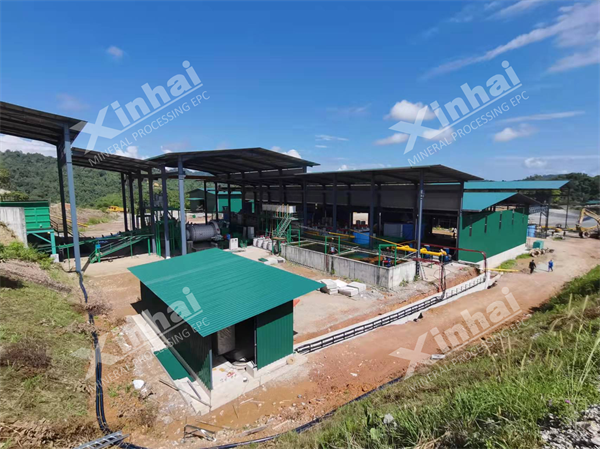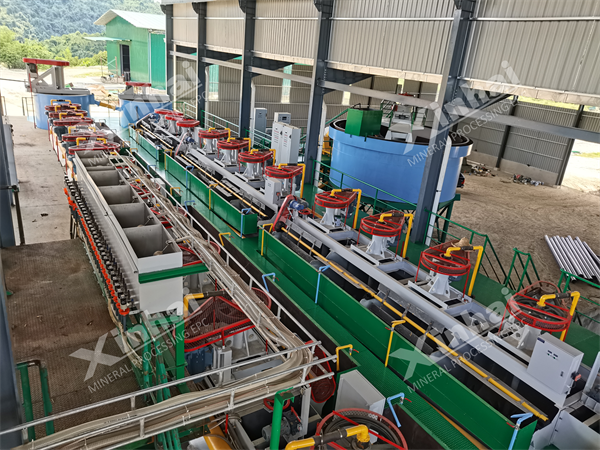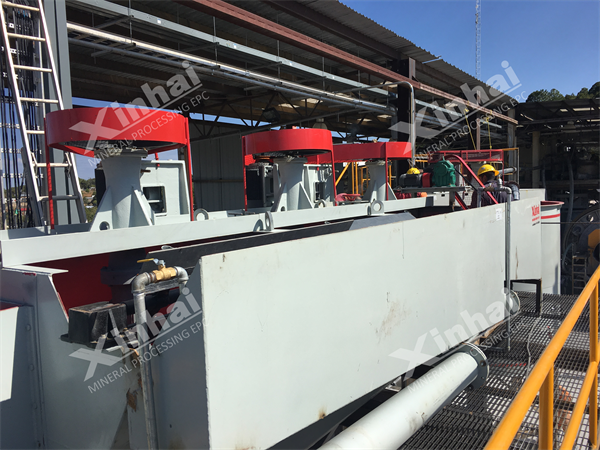Lead zinc ore is mainly composed of galena and sphalerite , galena has good natural floatability and belongs to the category of easily floating sulfide minerals, sphalerite has a certain degree of natural floatability. Therefore, the characteristics of mineral properties determine that the beneficiation process of lead-zinc ore is mainly based on flotation. However, the process flow used varies for different gangue minerals. This article will introduce four commonly used process flow of lead zinc ore flotation.

The flotation principles of sulfide lead zinc ore mainly include priority flotation process, fully mixed flotation process, partially mixed flotation process, equal floatability flotation process, asynchronous flotation process, and branch serial flow flotation process. When the ore contains sulfide iron minerals, sulfide copper minerals, etc., various forms of process flow are derived from the above principles process.
(1) Priority flotation process
Process characteristics: According to the floatability of lead zinc minerals, flotation separation of lead zinc minerals is carried out in sequence. Lead minerals and zinc minerals are recycled in their respective sorting cycles, and the process has strong adaptability to ore properties and good stability.
Scope of application: The lead and zinc content is high, and the embedded particle size between lead and zinc minerals is coarse and the symbiotic relationship is not close. It is advisable to separate individual minerals during grinding.
(2) Full mixed flotation process
Process characteristics: Lead zinc minerals are selected from mixed concentrates, and then separated to obtain a single concentrate product. Mixed flotation can timely dispose of tailings, reduce flotation equipment and lower reagent consumption; However, the mineral surface in the mixed concentrate is covered with a large amount of flotation agents, making flotation separation more difficult.
Scope of application: The lead and zinc content is relatively low, and the embedded particle size of lead and zinc minerals is fine and closely related to each other. During grinding, lead and zinc minerals are prone to forming connected bodies.
(3) Partial mixed flotation process
Process characteristics: The mixed flotation part of lead zinc ore contains minerals to be recovered, while suppressing other minerals, and then activating the flotation of other minerals to be recovered; The mixed concentrate that floats out first is then separated by flotation to obtain a single concentrate product.
Scope of application: Several minerals in the ore have similar floatability, but their floatability is different from other target minerals.
(4) Equal floating flotation process
Process characteristics: According to the floatability of lead zinc minerals, minerals with similar floatability are mixed in sequence, and then the mixed concentrate is separated separately to obtain a single concentrate product. Avoiding enhanced inhibition and enhanced capture can reduce the dosage of reagents, but the flotation process is complex and the operation control is difficult.
Scope of application: Suitable for flotation of lead zinc minerals with different floatability.
(5) Asynchronous flotation process
Process characteristics: In the same selection cycle, lead zinc minerals are flotation asynchronously under different operating conditions under their respective suitable conditions. Each selection cycle can achieve sufficient selection and recovery of lead and zinc minerals, and help create conditions for enhanced enrichment and recovery of associated gold and silver.
Scope of application: Suitable for flotation of the same type of lead zinc mineral with differences in floatability.

Lead zinc oxide ore mainly adopts direct flotation, sulfide flotation, and
chelating agent flotation methods. However, single oxide lead zinc deposits are
very rare and usually complex deposits with both oxide and sulfide minerals.
Therefore, segmented flotation of sulfide ore followed by flotation of oxidized
ore is often adopted.
The main process flow can be divided into: sequential
flotation of lead sulfide, lead oxide, zinc sulfide, and zinc oxide, followed by
sequential flotation of lead sulfide, zinc sulfide, lead oxide, and zinc oxide;
Due to the high lead content in zinc sulfide flotation caused by the easy
floatation of some lead oxide minerals, synchronous flotation of lead sulfide
and lead oxide is often used, that is, sequential flotation of lead sulfide+lead
oxide - zinc sulfide - zinc oxide.
(1) Sequential flotation process of lead followed by zinc
Process characteristics: Floatation is carried out in the order of lead sulfide lead oxide zinc sulfide zinc oxide. Beneficial for reducing the lead content in zinc concentrate, some easily floating zinc sulfide minerals are prone to float in the selection cycle of lead oxide minerals, and the excess sodium sulfide in the flotation cycle of lead oxide minerals can easily cause inhibition of zinc sulfide minerals. There are many types and large amounts of flotation reagents, and high control of the reagent system is required.
Scope of application: Ores with high lead and zinc content and relatively low oxidation rate.
(2) Sequential flotation process of sulfur followed by oxygen
Process characteristics: Flotation is carried out in order of lead sulfide zinc sulfide lead oxide zinc oxide. Zinc sulfide minerals float out before lead oxide minerals, which can avoid the inhibition of sodium sulfide on zinc sulfide minerals and is easy to activate during zinc sulfide flotation; It can avoid the influence of zinc sulfide on flotation of lead oxide, but the easily floating lead oxide floats up during the selection of zinc sulfide, which can easily affect the quality of zinc concentrate.
Scope of application: Ores with low lead and zinc content and relatively low content of oxidized lead and zinc minerals.
(3) Sequential flotation process from easy to difficult
Process characteristics: Flotation is carried out in sequence of lead sulfide+lead oxide - zinc sulfide - zinc oxide. It can reduce the floating of easily floating lead oxide during the selection of zinc sulfide, which is beneficial for reducing the lead content in zinc concentrate. The flotation process is relatively simple.
Scope of application: High lead oxidation rate, some lead oxide minerals are prone to flotation.
The density of lead and zinc minerals is generally higher than that of gangue minerals, especially lead minerals, making it possible to use gravity separation for lead and zinc ore. However, gravity separation is usually an auxiliary beneficiation method for lead and zinc ore beneficiation. In the application of gravity separation flotation combined process, gravity separation is mainly used for pre selection of waste, intermediate ore treatment, and tailings re selection pre enrichment. The application of gravity separation flotation combined process is more common in mixed lead and zinc ore and oxidized lead and zinc ore.
The properties of lead-zinc ore are complex. When the lead-zinc ore contains magnetic minerals such as sphalerite, pyrrhotite, and magnetite, magnetic separation is introduced in the flotation process to achieve synergistic separation of magnetic minerals and sulfide minerals, which can better improve the separation effect of the target ore. When obtaining high-grade concentrate, magnetic separation can be used to further remove sphalerite and other magnetic minerals from the concentrate product. Especially, magnetic separation of sphalerite and sphalerite from zinc concentrate is simpler and more efficient.

Some lead-zinc ores with complex ore properties are difficult to produce qualified concentrate products using conventional beneficiation techniques, or cannot achieve full resource recovery and utilization. Metallurgy has the advantages of good adaptability, strong targeting, and efficient operation in dealing with complex and difficult to beneficiate lead-zinc ores. The use of a combined beneficiation and smelting process effectively leverages the unique advantages of beneficiation and smelting.
The combined process of selection and smelting mainly includes the process of selection before smelting and the process of selection after smelting. The smelting technologies used mainly include biological metallurgy (bacterial biological leaching), pyrometallurgy (sulfur roasting), and wet metallurgy (acid leaching, ammonia leaching). The first selection followed by metallurgical process is mainly used for pre enrichment to reduce the production cost of subsequent metallurgical processes; The process of first smelting and then selecting is commonly used in metallurgical processes for pre leaching and recovering oxidized lead zinc ore from oxygen sulfur mixed lead zinc ore, or for pre-treatment and sulfurization of oxidized lead zinc ore, followed by flotation recovery.
The above introduces the single flotation process flow, gravity flotation combined process, magnetic separation flotation combined process, and beneficiation metallurgical combined process of lead-zinc ore, and introduces the characteristics and applicability of each process flow. Nevertheless, it is recommended that you first conduct beneficiation tests on the ore and determine the beneficiation process flow based on the test results in order to achieve full collection of receivables and avoid resource waste.